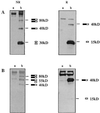MIC-1, a novel macrophage inhibitory cytokine, is a divergent member of the TGF-beta superfamily
- PMID: 9326641
- PMCID: PMC23523
- DOI: 10.1073/pnas.94.21.11514
MIC-1, a novel macrophage inhibitory cytokine, is a divergent member of the TGF-beta superfamily
Abstract
Macrophages play a key role in both normal and pathological processes involving immune and inflammatory responses, to a large extent through their capacity to secrete a wide range of biologically active molecules. To identify some of these as yet not characterized molecules, we have used a subtraction cloning approach designed to identify genes expressed in association with macrophage activation. One of these genes, designated macrophage inhibitory cytokine 1 (MIC-1), encodes a protein that bears the structural characteristics of a transforming growth factor beta (TGF-beta) superfamily cytokine. Although it belongs to this superfamily, it has no strong homology to existing families, indicating that it is a divergent member that may represent the first of a new family within this grouping. Expression of MIC-1 mRNA in monocytoid cells is up-regulated by a variety of stimuli associated with activation, including interleukin 1beta, tumor necrosis factor alpha (TNF-alpha), interleukin 2, and macrophage colony-stimulating factor but not interferon gamma, or lipopolysaccharide (LPS). Its expression is also increased by TGF-beta. Expression of MIC-1 in CHO cells results in the proteolytic cleavage of the propeptide and secretion of a cysteine-rich dimeric protein of Mr 25 kDa. Purified recombinant MIC-1 is able to inhibit lipopolysaccharide -induced macrophage TNF-alpha production, suggesting that MIC-1 acts in macrophages as an autocrine regulatory molecule. Its production in response to secreted proinflammatory cytokines and TGF-beta may serve to limit the later phases of macrophage activation.
Figures





References
-
- Harris P, Uman R P. J Leukocyte Biol. 1985;37:407–422. - PubMed
-
- Valenzuela S M, Martin D K, Por S B, Robbins J M, Bootcov M, Schofield P R, Campbell T J, Breit S N. J Biol Chem. 1997;272:12575–12582. - PubMed
-
- Bennett S, Por S B, Cooley M A, Breit S N. J Immunol. 1993;150:2364–2371. - PubMed
-
- Bennett S, Por S B, Stanley E R, Breit S N. J Immunol Methods. 1992;153:201–212. - PubMed
Publication types
MeSH terms
Substances
Associated data
- Actions
LinkOut - more resources
Full Text Sources
Other Literature Sources
Molecular Biology Databases

